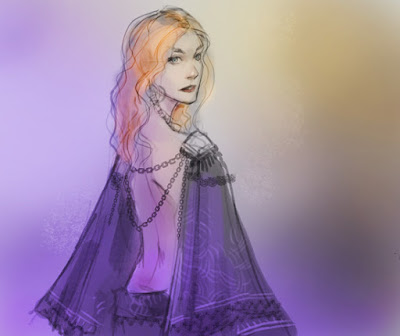The complementary color scheme is made of two colors that are opposite each other on the color wheel. This scheme looks best when you put a warm color against a cool color, for example, red versus green-blue. The complementary scheme is intrinsically high-contrast.
Here is a traditional Color Wheel: The opposite pole are the true complementary color. You can play around and have it slightly wider in range, it will possibly work out if you figure out how to harmonize them.

Here is digital color wheel. It is slightly different, but the principle remains. For precise accuracy of complementary, look at the traditional wheel.

When using the complementary scheme, it is important to choose a dominant color and use its complementary color for accents. Using one color for the background and its complementary color to highlight important elements, you will get color dominance combined with sharp color contrast.
Example: *This one is the closet to the complimentary color scheme I could find at the moment. It is somehow on the boarder line...it could be split complimentary because of the range of hue in the picture. But you get the idea...it's still in the same family.

Pros: The complementary color scheme offers stronger contrast than any other color scheme, and draws maximum attention.
Cons: This scheme is harder to balance than monochromatic and analogous schemes, especially when desaturated warm colors are used.
Tips: 1. For best results, place cool colors against warm ones, for example, blue versus orange.
2. If you use a warm color (red or yellow) as an accent, you can desaturate the opposite cool colors to put more emphasis on the warm colors.
3. Avoid using desaturated warm colors (e.g. browns or dull yellows).
4. Try the split complementary scheme; it is similar to the complementary scheme but offers more variety.
*The split complementary scheme is a variation of the standard complementary scheme.
It uses a color and the two colors adjacent to its complementary. This provides high contrast without the strong tension of the complementary scheme.

Pros: The split complementary scheme offers more nuances than the complementary scheme while retaining strong visual contrast.
Cons: The split complementary scheme is harder to balance than monochromatic and analogous color schemes.
Tips: 1. Use a single warm color against a range of cool colors to put an emphasis on the warm color (red versus blues and blue-greens, or orange versus blues and blue-violets).
2. Avoid using desaturated warm colors (e.g. browns or dull yellows), because this may ruin the scheme.
Related Article:
-Basic Color Scheme for Artist, Monochromatic.
-Color temperature warm vs cool for artist.
More Art resource:
-How to pick pencils for drawing
-5 tips to improve drawing skill for artist.
-Basic Element of good design for artist.
New tutorials:
-Gatorfish or Fish-Gator Creature Design drawing.
-Drawing Mecha Bike
-How to sketch a Sorcerer Pink
-Manga tutorial, how to draw and color pirate girl.
-Drawing and Painting Blonde Girl with Double Pistols
-Painting tutorial, woman by the window
-Learn to paint woman portrait step by step.
-Digital painting tutorial, Sleeping Beauty speedpainting.
FEATURE TUTORIAL:
-How to draw and paint faces: Face Constructed tutorial
-Drawing and painting woman's body basic: Female Manga Fusion I
-How to draw and paint woman's body: Female Manga Fusion II
-How to Design Manga Characters: Archetypes I
-Character Design Tutorial: Dark Valkyrie
-Free Art tutorials download and more

0 comments:
Post a Comment